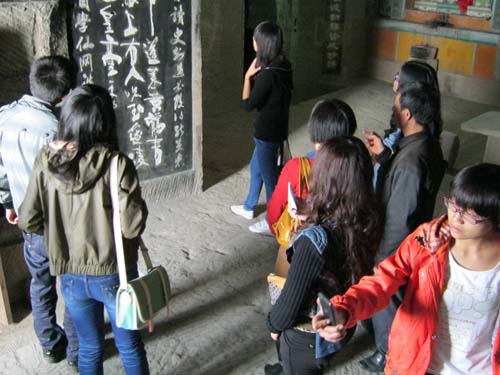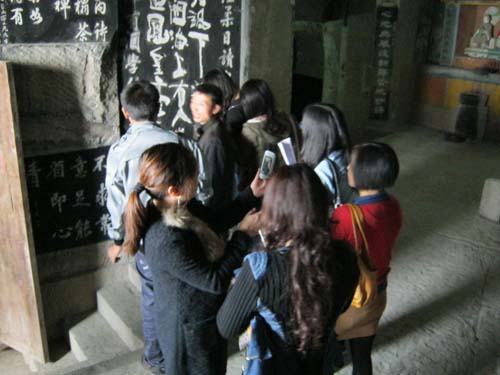Once getting in the cave, tourists may feel as if they were in a exhibition hall of calligraphy – ground floor and the stonewalls of upper and lower corridors and any other possible places are carved with calligraphy works of various sizes. In terms of words, the biggest ones can be over 2 feet in size and the smallest ones can be as small as walnuts. It is estimated that the walls of the cave are carved with 152 calligraphy works in styles of Kai, Xing, Zhuan and Li, with more than 19,600 words and covering an area of 160m2. The story turns out to be that: Jia Ruzhen liked making friends and particularly loved contacting with poets and scholars. Some of those calligraphies were written by calligraphers at Jia’s invitation when they visited here, and others were engraved based on calligraphers’ handwriting got by Jia when he paid personal visits to them.
 |
| vListening to the administrator in an interview |
As regards the contents, the calligraphy works include poem, tablets, couplets and inscriptions; in terms of writing style, some are vigorous, and some are graceful; from the writer point of view, it involves as many as 21 famous calligraphers according to “Province Annals of Sichuan” and “Annals of Baoning Prefecture”. Of all works the most remarkable one would be the inscription of “Hui An Dong Tian” by Cabinet Minister Li Jiaxiu, “Dong Tian Fu Di” by Xu Bo – the county magistrate of Langzhong and works by Gong Youhui, Guo Shangxian, Kong Jiyu, Lin Chunyuan and other famous calligraphers in Qing Dynasty. In addition to calligraphy works, there are stone statues of the Goddess of Mercy, eight immortals (Zhang Guolao, Cao Guojiu, Zhong Lihan, Han Xiangzi, Lv Dongbing, Li Tieguai, Lan Caihe and He Xiangu), 5 reliefs and 9 frescos about Sutra stories.
 |
| Listening to the administrator in an interview。 |
Except for teaching, publishing is another function of schools, especially for those outstanding ones in ancient times, and that is the case with Scripture Crag for Happiness. According to local historical materials, after expanding the cave, on the hillside outside the cave Jia built another several houses named “Bamboo Bridge Study”. As the supporting project and extension of the Scripture Crag for Happiness, the Bamboo Bridge Study was a place for publishing books. In order to ensure the quality of books, Jia splashed out on hiring local and foreign experienced craftsmen to carve the Four Books, Five Classics and Integration for Primary School Students. For the superior quality, the books were not only for the consumption of students in his school, but selling to other places. To store published books, Jia, by making full use of originally narrow mountainside area, set up a stone fence and built a pavilion named “Tai Fang Lang”. |

